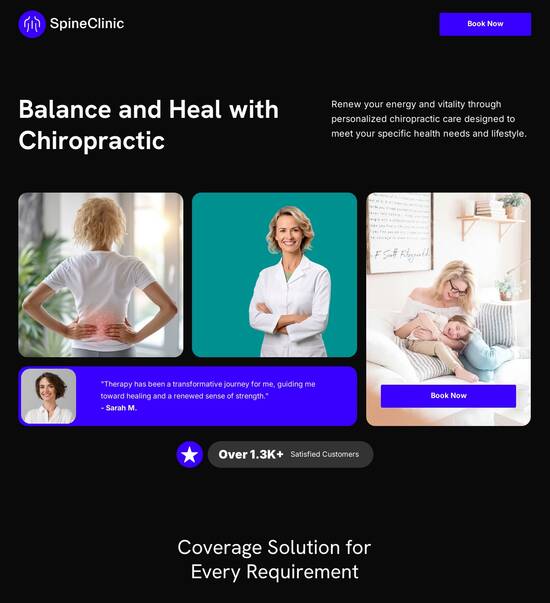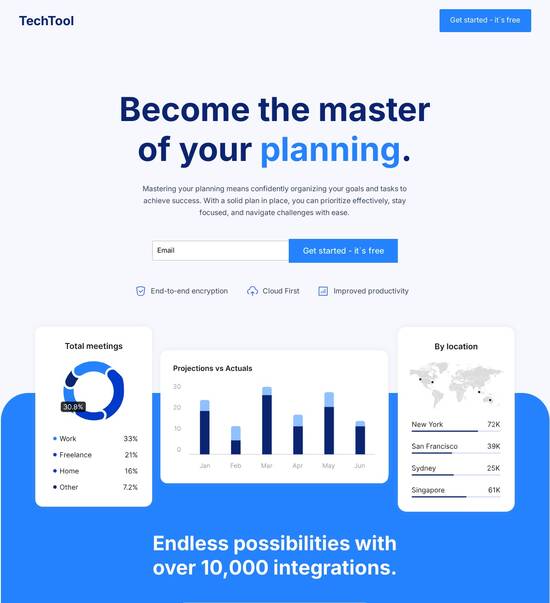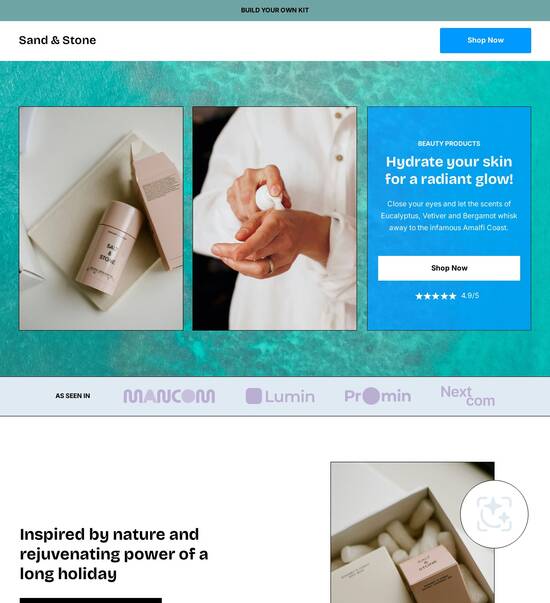
Design Chromium-ready service unavailable page templates
Explore Similar TemplatesAbout template
Choose the best service unavailable page template for Chromium
Recommended templates

Easy to build without coding
With the intuitive drag-and-drop builder, anyone on your team can create high-converting pages without any knowledge of code or design. Make enhancements to your landing page with custom widgets using Javascript, HTML/CSS, or third-party scripts.

Multiple layouts for any industry and goal
Select from 500+ landing page layouts built to boost conversions across industry-specific scenarios. Customize them by adjusting fonts, adding images, and generating on-brand content with the AI assistant. Quickly scale with Instablocks® and Global Blocks that you can save, reuse, and update globally.

Loads fast and looks polished on any device
Every template is responsive, which means they present professionally on any device and load blazingly fast with our Thor Render Engine. You can also power them up with Google AMP technology to deliver an unparalleled mobile experience and drive higher conversions.

Robust analytics & experimentation
Get real-time updates and reporting across all your devices, showing the number of visitors, conversions, cost-per-visitor, and cost-per-lead. Launch AI-powered experiments, run A/B tests, and use heatmaps to analyze user behavior, then optimize your landing page to maximize conversions.







Easy to build without coding
With the intuitive drag-and-drop builder, anyone on your team can create high-converting pages without any knowledge of code or design. Make enhancements to your landing page with custom widgets using Javascript, HTML/CSS, or third-party scripts.
Multiple layouts for any industry and goal
Select from 500+ landing page layouts built to boost conversions across industry-specific scenarios. Customize them by adjusting fonts, adding images, and generating on-brand content with the AI assistant. Quickly scale with Instablocks® and Global Blocks that you can save, reuse, and update globally.
Loads fast and looks polished on any device
Every template is responsive, which means they present professionally on any device and load blazingly fast with our Thor Render Engine.
Robust analytics & experimentation
Get real-time updates and reporting across all your devices, showing the number of visitors, conversions, cost-per-visitor, and cost-per-lead. Launch AI-powered experiments, run A/B tests, and use heatmaps to analyze user behavior, then optimize your landing page to maximize conversions.
All the features you need to build lead-generating landing pages
Explore more featuresLearn how to build top-performing landing pages for any goal
FAQs
Leading the way in building high-performing landing pages





A step-by-step guide for creating a service unavailable page template optimized for Chromium
Creating an effective service unavailable page is crucial for maintaining user experience and communication during downtime. Instapage's features empower marketers to design engaging and informative pages that can help retain visitors, rather than losing them altogether. With a commitment to optimization and conversion, this guide will provide you with step-by-step instructions to craft an informative service unavailable page template.
Understanding the Importance of a Service Unavailable Page
A well-designed service unavailable page reassures users while your site experiences issues. Such pages can effectively reduce bounce rates and retain user interest for future visits. Using Instapage, you can create these pages easily using customizable templates that optimize for Chromium, ensuring compatibility across different browsers.
- User Communication: Clearly inform users why the service is unavailable and when it may return, fostering transparency.
- Branding: Ensure your page maintains brand consistency with appropriate logos and color schemes, reinforcing your identity even during outages.
- Call-to-action: Provide users with options, such as chances to subscribe for updates or links to social media for real-time updates.
Step 1: Choose the Right Template
Begin by selecting an appropriate template from Instapage's library. Look for high-conversion models specifically designed for service unavailable notices. Use the intuitive drag-and-drop builder to customize elements according to your brand's voice and identity.
- Select a template: Choose a template that suits the nature of your service.
- Customize Text: Modify any default text to align with your brand’s message and tone.
- Include visuals: Add relevant images or logos to maintain brand presence.
Step 2: Optimize for User Experience
Next, ensure that the page is optimized for user experiences, such as loading speed and visual clarity. With Instapage's built-in experimentation features, you can analyze user interaction and adjust elements that may hinder clarity.
- Mobile optimization: Ensure your page is mobile-friendly to cater to users on all devices.
- Loading speed: Keep designs minimalistic to enhance loading times, avoiding distractions.
- A/B Testing: Utilize A/B testing capabilities to find out which layouts get the best responses.
Step 3: Implement Continuous Communication
Implement continuous communication strategies to engage users while the service is unavailable. Integrating elements like subscription boxes or social media links can keep users connected.
- Subscription Forms: Allow users to sign up for notifications when your services are back online.
- Social Media Linkage: Provide links to your social media channels for the latest updates.
- Feedback Opportunities: Enable users to share their experiences or ask questions even when service is down.
By following these steps, marketers can create effective service unavailable page templates ensuring a seamless user experience, even during downtime.
Don't let downtime dissuade your visitors. Start utilizing Instapage to design a service unavailable page today and keep your brand alive and engaged in every situation!
Service unavailable page template optimized for chromium
Understanding service unavailable page templates in chromium: An in-depth exploration
When a web service becomes inaccessible, users often encounter a 'service unavailable' page, typically linked to the HTTP status code 503. This status code signifies a temporary inability to handle requests, hinting at server overload or scheduled maintenance. It's crucial for organizations to effectively communicate with users during these disruptive times, emphasizing that downtime is often a temporary state rather than a permanent issue.
Given the increasing reliance on web applications for business operations, optimizing the service unavailable page is vital. Users reacting negatively to an awkward or uninformative error page can lead to frustrations and lost trust in the brand. Therefore, although users may not appreciate an outage, a well-crafted response can help manage their expectations and maintain a positive relationship with the brand.
The importance of an optimized service unavailable page
The 'service unavailable' page has significant implications for user experience and retention. It's essential to keep users informed, and the presence of a customized error page fosters communication that a brand values its customers. Furthermore, optimization enhances website SEO rankings, increasing the chances of traffic returning after the outage.
Clearly state that the service is unavailable to manage expectations.
Ensure branding elements are present to reinforce familiarity.
Incorporate a contact option or support link.
Technical foundations of service unavailable pages
Understanding the functioning of an application’s backend is crucial for optimizing service unavailable pages. The underlying HTTP protocol plays a key role in this process. HTTP establishes a framework for communication between a client and a server, where status codes like 503 inform clients about the current state of a server. The proper implementation of these codes is critical, as they indicate temporary or permanent errors.
An application pool manages multiple web applications running on a server, influencing their availability. If an application pool fails due to memory issues, high traffic, or incorrect configurations, services may become unreachable. Diagnosing pool-related problems typically involves checking server logs and monitoring performance metrics to identify root causes.
Building the service unavailable page template
A comprehensive service unavailable page template should comprise several core components to ensure it effectively communicates with users. Essential content elements include a clear message indicating that the service is temporarily unavailable, along with appropriate branding to remind users of the established identity they trust. This helps in minimizing user frustration and assures them that the situation is under control.
Creating a user-friendly message is also fundamental. When crafting messages, aim for a tone that is both friendly and informative. Avoid technical jargon while clearly explaining that the service is disrupted. Here are some tips for effective messaging:
Use simple language to ensure that all users understand.
Consider adding an estimated timeframe for resolution.
Provide a direct link to customer support for further assistance.
Optimizing for chromium
Chromium is a widely used open-source browser engine known for its speed and performance potential. When optimizing a service unavailable page for Chromium, web developers should consider various rendering challenges. This includes ensuring that the page loads quickly and displays accurately across different devices and screen sizes.
Testing the page in major Chromium-driven browsers, including Google Chrome and Microsoft Edge, is essential. These browsers may interpret HTML and CSS differently, leading to inconsistencies in user experience. Therefore, thorough testing methods can include utilizing browser developer tools and engaging with real-user monitoring tools. This helps identify visual discrepancies and performance issues.
Best practices for error handling in web applications
Service disruptions can arise from various issues, such as server overload or inefficient configuration settings. Addressing these underlying problems often requires proactive server management strategies. Regular monitoring and performance evaluations form part of this responsive management framework, allowing issues like application pool failures to be diagnosed swiftly. Employing alerting systems ensures that administrators instantly know when service disruptions occur.
User expectations must also be addressed during downtimes. It's important to maintain transparent communication, offering users insights on the current state of affairs and the anticipated resolution time. Following this, providing them with alternative content or support resources can enhance their experience even in the face of downtime.
Community insights and real-world case studies
Learning from community experiences in web technologies can be incredibly beneficial. Forums and social media groups often discuss troubleshooting techniques, best practices, and examples of both successful and ineffective implementations. Engaging in these communities can provide actionable insights for marketers and developers alike.
Real-world case studies of effective service unavailable pages can also serve as learning tools. For instance, companies like Microsoft have tailored their error pages not only to inform users but also to guide them to other resources like customer support or social media channels. Analyzing different strategies can help derive lessons that can be applied across various industries.
The future of service unavailable pages in web development
With ongoing advancements in AI and machine learning, the future of error handling could involve more intelligent systems that predict and mitigate downtimes before they affect users. These technologies can enhance understanding and visualization of application performance, leading to improved preemptive responses.
Moreover, as serverless infrastructures continue to gain traction, the number of service disruptions may dwindle. This architectural evolution helps balance loads and manage resources efficiently, potentially diminishing the necessity for service unavailable pages. As user experience design evolves, error communication strategies will likely become increasingly intricate, aiming to provide seamless transitions even during disruptions.
Practical implementation: Step-by-step guide
Creating a custom service unavailable page involves a process that ensures effectiveness and clarity in communication. Start by sketching out the layout and the core message elements. Next, code the page, ensuring you utilize SEO best practices such as integrating appropriate meta tags and descriptions. It's vital to ensure that the page reflects awareness of user queries and provides them with potential alternatives.
Remember to test your page across different browsers, with a particular focus on various Chromium-based platforms to maintain consistency. Regularly updating and optimizing the page’s content ensures it remains relevant and continues to serve the expected audience effectively. Also, deploying analytics tools helps track user interactions with the error page, providing important insights for future improvements.
Measuring the impact of your efforts
After deploying the service unavailable page, it's essential to analyze user behavior during outages. Implementing tools to track interactions with the error page can provide vital metrics that reveal how well it's performing. Key performance indicators may include user exit rates and average time spent on the page, giving insights into user engagement.
Establishing feedback loops can also enhance learning during service disruptions. By collecting user input through polls or feedback forms, organizations can refine the messaging and overall user experience. Using this data to iterate on the service unavailable page will encourage continual improvement, ultimately fostering a stronger user connection even during challenging times.
Engaging readers through innovative error handling
Continuing to innovate error handling mechanisms becomes integral in web development. When users experience a service unavailable situation, it can become an opportunity to enhance future interactions. By fostering a proactive mindset, organizations can prepare for unforeseen disruptions and communicate more effectively.
Adopting best practices laid out in this article not only reduces frustration but also reinforces brand trust through transparency. By continually refining service unavailable communications and learning from past errors, brands can ensure smoother recovery processes, maintaining customer loyalty long-term.
Ready to skyrocket conversions?
Supercharge your ad campaigns with high-performing landing pages
Get started














